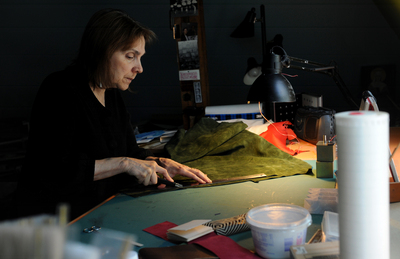Barbara Brown's art books go beyond the page
After 15 years of making art books, Ann Arbor artist Barbara Brown is still carving out new edges in her work — literally.

Local artist Barbara Brown cuts a piece of leather at her desk in her home studio.
Melanie Maxwell | AnnArbor.com
While some of her artworks take the shape of conventional books, many of them push the boundary of what people consider a book to be. Some of her art books feature text, while others let you glean your own story solely from her aesthetic structures and visual imagery. It even helps to have an open mind about what exactly constitutes a page in an encounter with a few of Brown’s more experimental pieces.
“I just keep getting more and more interested in alternative constructions,” Brown says.
Brown’s journey toward becoming a book artist began with a love of textiles like sewing and quilting, as well as paper making. After running into her friend Tom Hogarth about 15 years ago at a coffee shop, the pair struck up a deal. Hogarth, now senior conservator for the University of Michigan Library, “wanted to learn how to do paper making and I wanted to know how to do bookbinding, so we traded each other lessons. He taught me how to sew my first book,” she remembers.
She set out to learn fine bookbinding over the course of six years at the American Academy of Bookbinding in Telluride, Colorado, under the tutelage of prominent book binder designer Tini Miura. Brown is currently a member of theWSG Gallery and curates a recurring book art exhibition and panel series “Beyond Words: a Celebration of Book Arts,” which features diverse local and visiting artists. Beyond creating her own art books, Brown also teaches students as a workshop instructor at Hollander’s School of Book and Paper Arts. She also runs independent workshops, works with teenagers at the Rudolf Steiner High School, and visits the writers in the Lloyd Hall Scholars Program once a semester, among other endeavors.
Most of her bookbinding compatriots in Telluride and conservationists like her friend Tom Hogarth do not consider themselves to be fine artists, but rather frequently self-identify as things like “fine craftsmen,” according to Brown. She sees “a big difference” between her fine book art and what they do. For example, examples of Miura’s leather bindings feature cutouts and designs that are artfully done, however “they don’t have alternative structures or bindings,” she explains. On the other hand, Brown’s art books experiment with unconventional constructions and they incorporate things like collage, digital imagery, and poetry.
Brown reports finding a lot of debate over how to define an “art book” within the art book and bookbinding community. “You can really get into some squabbling about what an artistic book really is. If you ask a book artist to start off by defining what an artist book is, you can get into some real discussion and really strong disagreement.” she says. Some of this disagreement comes from the fact that art books take so many different forms. Her works surely do.
Although not all of her books feature it, “one of the things that will often start me in a direction with imagery will be text,” Brown says. Her series of art books exploring the 4 elements features poems written by her sister Jane Brown, which inspired the imagery.
The use of text might suggest that the works are obviously books; however, the artist uses the text in unconventional ways. For example, in “Prometheus” (a symbol of the element of fire), lines of poetry are pasted around the central figure, while the pages resemble layer upon layer of lapping flames fanning out from the mythical figure. Although the flames are pages, the work can be stood upright — more like a sculpture than a book. In another work in the series, “The Messengers” (which explores the elements of air), mostly features imagery with the poem tucked into a pocket. Other examples of Brown’s works don’t have any text, leaving the reader to interpret their themes or stories based on visual clues and aesthetic features, “almost like a child” finding meaning in the images of his storybook, according to the artist.
One of Brown’s favorite parts of making art books is playing around with different shapes, binding techniques and structures. Right now she is working on a new “theater book” that folds out with parts cut out so that you can look back into its “tunnel,” she explains. Her new 1 won’t feature any text at all. “They’re almost like little set designs,” Brown says. Another work she made last year, entitled “Game Over,” looks more like a puzzle than a book. The work features 6 blocks with images on each of their sides that can be flipped around in different configurations, which you could say act as “the pages,” she suggests.
This summer, Brown will be doing another summer artist residency at Hollander’s with fellow artists Alvey Jones and Marilyn Prucka. During the Ann Arbor Art Fairs and the week after, the artists will facilitate artmaking projects that will be open to the public and suitable for people with any level of artmaking experience. Activities will be offered from noon to 3 p.m.
Jennifer Eberbach is a free-lance writer who covers art for AnnArbor.com.

